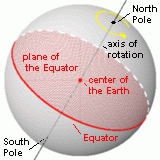The Earth

|
In a rough approximation, the Earth can be regarded as
an oblate spheroid (a sphere flattened at the poles). Measurements of its
exact dimensions and the amount of flattening are subjects of geodesy.
|
|
With the increasing accuracy of modern satellite based navigation systems, the
irregular form of the Earth is gradually becoming an important performance
limiting issue.
However, for almost all navigational purposes, the Earth can be assumed to be
a perfect spherical body without introducing any significant errors in position,
distance or speed.
|
The Geographical Poles
The Earth is a celestial body embedded in our solar system and is subject
to a complex motion. The primary components of the motion of the Earth are:
- the spinning around the Earth proprietary axis,
- the rotation around the Earth-Moon mass center and
- the orbiting around the Sun.
 |
|
The spinning of the Earth can be experienced directly by observing
the daily motion of the celestial bodies through the sky. A complete revolution
over 360° is completed in 23 hours and 56 minutes (a sidereal day). This spinning motion
is the basis for our natural - or biological - feeling of time.
The axis of rotation involved in the spinning motion, includes the
center of the Earth as well as two locations on the surface of the Earth.
These points are called geographical poles. By convention they are
named North Pole and South Pole. Seen from the center of the Earth the North
Pole is the geographical pole, currently directed to the star "Polaris".
|
The Equator
A plane perpendicular to the axis of rotation
of the Earth, and including the center of the Earth will divide the globe
into two equal parts. The part containing the North Pole is called northern
hemisphere; the other half of the globe, comprehending the South Pole, is
called the southern hemisphere.
The line of intersection of this plane with the surface of the Earth
is called the Equator
The length of the Equator is 40076 km. As a result of the Earth
rotation, any object located on the Equator is being moved through space
by this distance in 24 hours. This implies a tangential velocity of
(40076 km / 24 h ) or 1670 km/h.
|
|

|
Great Circles and Small Circles
A great circle is the line of intersection between the surface
of Earth and a plane passing through the center of the Earth. The center
of the Earth is also the center of all possible great circles. The plane
defining a great circle must be a plane which divides the globe into two
equal parts.
Any two points on the Earth can be connected with a segment of a great
circle. This has some importance for navigation, since the segment of a great
circle connecting two arbitrary points on the Earth is the path of shortest
distance between these points (for a spherical Earth).
This shortest route is called geodesic.
Although the great-circle segment connecting two points on the surface
of the Earth, is the shortest route between these points, sailing this great-circle
segment requires navigating a track with a continually changing course.
A small circle is the line of intersection of the Earth surface
and an arbitrary plane which does not include the center of the Earth.
|